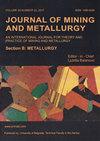卷取温度对热机械轧制S700MC钢组织和性能的影响
IF 1
4区 材料科学
Q3 METALLURGY & METALLURGICAL ENGINEERING
Journal of Mining and Metallurgy Section B-Metallurgy
Pub Date : 2022-01-01
DOI:10.2298/jmmb220304028o
引用次数: 1
摘要
无硼S700MC钢通常是利用铁素体-贝氏体混合显微组织的性能生产的,这种组织是在450℃左右的温度下盘绕钢带形成的。C,即低于贝氏体起始温度。为了进一步提高6 ~ 10mm厚带材的机械性能,在600℃的卷取温度下进行了工业试验。C已进行,以促进铁素体和碳化物的结构的形成,这也是可接受的钢等级。出乎意料的是,得到了由铁素体和马氏体组成的微观组织。与铁素体-贝氏体等级相比,新组织的屈服点略有降低,但极限抗拉强度提高不小于80 MPa,屈服行为从准不连续向明显连续转变。相应的,屈服抗拉强度比从0.90降低到0.75,冲击能分别降低35 J和60 J。在高温下盘绕的钢带的力学行为可以解释为硬相穿插在软铁氧体基体中的双相结构的直接结果。马氏体的存在可以通过所谓的不完全贝氏体反应来证明。由于碳的富集,在较低的温度下不可能形成贝氏体,因此线圈冷却所需的较长时间使尚未转变的奥氏体稳定下来。本文章由计算机程序翻译,如有差异,请以英文原文为准。
Effect of coiling temperature on the structure and properties of thermo-mechanically rolled S700MC steel
Boron-free S700MC steel is usually produced exploiting the properties of a ferrite-bainite mixed microstructure formed by coiling the strips at a temperature of about 450?C, namely below the bainite start temperature. Aiming at further enhancing the mechanical properties for 6 to 10 mm thick strips, industrial trials with a coiling temperature of 600?C have been carried out to promote the formation of a structure of ferrite and carbides, which is also acceptable for this steel grade. Unexpectedly, a microstructure composed of ferrite and martensite has been obtained. Compared with the ferritic-bainitic grade, the new structure is characterized by a slight decrease of the yield point but by an increase of the ultimate tensile strength of not less than 80 MPa, with a transition from a quasi-discontinuous to a clearly continuous yielding behaviour. Accordingly, the yield-to-tensile strength ratio decreases from 0.90 to 0.75 and the impact energy decreases of 35 J and 60 J for the two gauge levels, respectively. The mechanical behaviour of the strips coiled at high temperature is explained as a direct consequence of the dual phase structure with hard phase interspersed in a soft ferrite matrix. The presence of martensite is justified by invoking the so-called incomplete bainite reaction. The partial transformation in ferrite after coiling and the long time necessary for the coil to cool down stabilize the not yet transformed austenite due to the carbon enrichment making the bainite formation impossible at lower temperatures.
求助全文
通过发布文献求助,成功后即可免费获取论文全文。
去求助
来源期刊
CiteScore
2.00
自引率
40.00%
发文量
19
审稿时长
2 months
期刊介绍:
University of Belgrade, Technical Faculty in Bor, has been publishing the journal called Journal of Mining and Metallurgy since 1965 and in 1997 it was divided in two independent journals dealing with mining and metallurgy separately. Since 2009 Journal of Mining and Metallurgy, Section B: Metallurgy has been accepted in Science Citation Index Expanded.
Journal of Mining and Metallurgy, Section B: Metallurgy presents an international medium for the publication of contributions on original research which reflect the new progresses in theory and practice of metallurgy. The Journal covers the latest research in all aspects of metallurgy including hydrometallurgy, pyrometallurgy, electrometallurgy, transport phenomena, process control, solidification, mechanical working, solid state reactions, materials processing, surface treatment and relationships among processing, structure, and properties of materials.

 求助内容:
求助内容: 应助结果提醒方式:
应助结果提醒方式:


